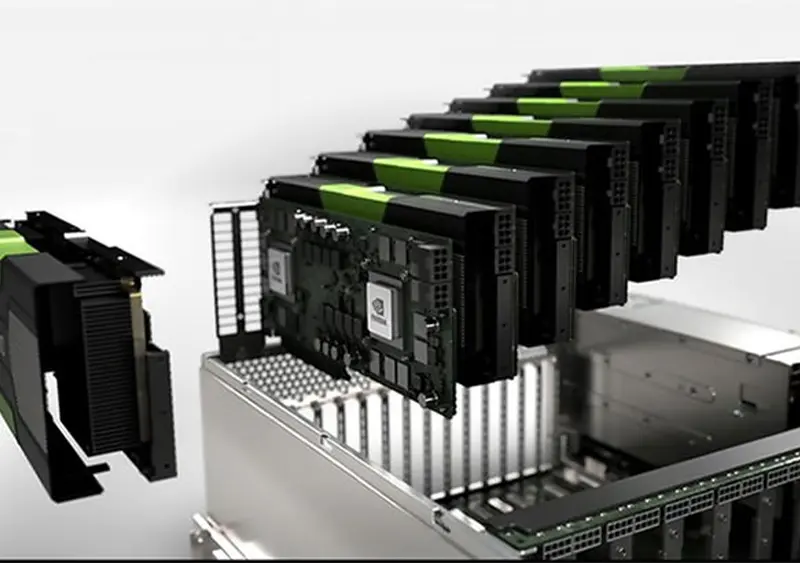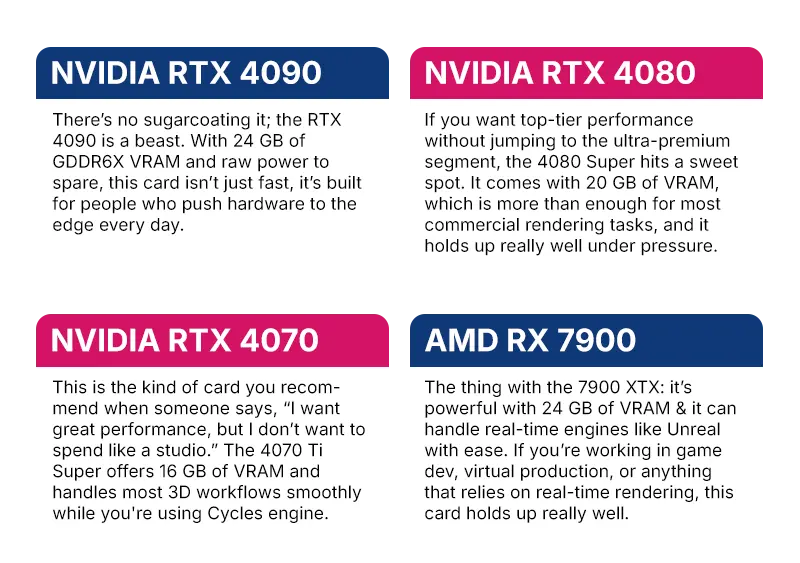Best GPU for 3D Rendering in 2025
“Unlock photorealism – one GPU at a time.”

6 MIN READ
July 16, 2025

Written By
Harish Selvaraj
Introduction
Ask anyone who works in 3D long enough, and they’ll tell you: your GPU can either make your workflow smooth or painfully slow. Whether you're animating a product spin, rendering a walkthrough, or simulating lighting in a complex scene, the graphics card does most of the heavy lifting.
The most expensive GPU isn’t always the right one. It depends on what you're working on. If you're doing real-time product demos, you’ll care about speed in the viewport. If you're rendering detailed interiors or animations, raw performance and memory matter more.
And now, in 2025, there are way too many options. Every card promises better speeds, more cores, and cooler features. But all that means very little unless you know how it performs inside the software you actually use.
This guide is about real workflows, not just technical specs. What works well, what’s worth the money, and what to avoid if you’re rendering professionally.

What are the best GPUs for 3D Rendering in 2025?
1. NVIDIA RTX 4090
There’s no sugarcoating it; the RTX 4090 is a beast. With 24 GB of GDDR6X VRAM and raw power to spare, this card isn’t just fast, it’s built for people who push hardware to the edge every day.
If you’re working on large environments, high-poly models, or full-scene simulations in tools like Blender, Houdini, or Maya, this card rarely flinches. You can throw particle systems, fluid simulations, and ray-traced lighting at it, and it will still give you real-time feedback without lag.
Yes, it's expensive. But in professional pipelines where rendering time equals money, the 4090 often pays for itself just by shaving hours or days off production schedules.
Best for:
- Final-frame animation
- Complex lighting and shading workflows
- Heavy simulations (smoke, fluids, particles)
- High-resolution architectural renders
2. NVIDIA RTX 4080 Super
If you want top-tier performance without jumping to the ultra-premium segment, the 4080 Super hits a sweet spot. It comes with 20 GB of VRAM, which is more than enough for most commercial rendering tasks, and it holds up really well under pressure.
In Blender, for example, you can work on complex animation scenes, load up multiple 4K textures, and still get decent real-time playback. It doesn’t have the brute force of the 4090, but for most artists and small studios, you probably won’t feel the difference unless you’re rendering at a massive scale.
This is a card that gives you breathing room without emptying your budget.
Best for:
- Product animations and turntables
- Interior design visualization
- High-res compositing and texture-heavy workflows
3. NVIDIA RTX 4070 Ti Super
This is the kind of card you recommend when someone says, “I want great performance, but I don’t want to spend like a studio.” The 4070 Ti Super offers 16 GB of VRAM and handles most 3D workflows smoothly whether you're using Redshift, Octane, or Blender’s Cycles engine.
It’s a favorite among solo creators and motion designers. You can do a lot with this card: short films, stylized 3D animation, social media content, even some basic simulations. It’s not meant for super heavy scenes, but for daily creative work, it's reliable and responsive.
If you're building your first serious 3D workstation, this card won’t disappoint.
Best for:
- Stylized motion graphics
- Short-form animations
- Instagram or YouTube content in 3D
4. AMD Radeon RX 7900 XTX
Here’s the thing with the 7900 XTX: it’s powerful, it’s got 24 GB of VRAM, and it can handle real-time engines like Unreal with ease. If you’re working in game dev, virtual production, or anything that relies on real-time rendering, this card holds up really well.
Where it falls short is in software support. Most GPU renderers still lean on NVIDIA’s CUDA cores, and AMD just isn’t part of that ecosystem yet. So if you’re planning to use Octane, Redshift, or even Blender’s Cycles with full GPU acceleration, this might not be the card for you.
But if your work is built around real-time rendering or OpenCL-based tools, the 7900 XTX gives you serious performance at a better price point.
Best for:
- Unreal Engine workflows
- Game asset development
- Virtual production pipelines
How to Choose the Best GPU (Based on Rendering Type)?
Before buying a GPU, ask yourself: What kind of rendering do I actually do most?
- Offline ray-tracing (Cycles, Redshift, V-Ray): Prioritize NVIDIA. CUDA support is non-negotiable.
- Real-time rendering (Unreal, Eevee): You can go with either NVIDIA or AMD.
- Simulation-heavy workflows (Houdini, Blender Physics): Look for more VRAM and higher core count.
- Viewport performance (sculpting, modeling, animation): Even mid-range cards work well here, especially with optimized drivers.
For a deeper breakdown of different rendering approaches, check out our guide on how 3D rendering works.
Also consider your software pipeline. For example, some Blender artists split their tasks between Eevee (preview) and Cycles (final render). In that case, CUDA acceleration for Cycles is critical.
Laptop vs Desktop GPU: Know the Limits
Laptop GPUs like the RTX 4080 mobile edition are powerful enough for basic and mid-range rendering. But there's a thermal ceiling sustained performance during long renders is often throttled. And power draw is capped, so clock speeds don’t match desktop equivalents.
If you travel or present work on-site, a high-end workstation laptop is viable. But for daily rendering, simulation, and multitasking, a well-cooled desktop with proper airflow and a full desktop GPU is still the best setup.
Other Factors to Consider Before You Buy
1. VRAM Size
More VRAM means bigger texture support
and more complex scenes without memory crashes. Aim for at least 16 GB for serious rendering.
2. Cooling & PSU Requirements
High-end GPUs demand power and ventilation. The RTX 4090, for instance, often needs a 1000W PSU and 3-slot
clearance. Don’t skimp on power.
3. Software Optimization
Some apps run better with Studio Drivers (NVIDIA) rather than Game Ready Drivers. Always test for stability before
starting a commercial project.
4. Future-Proofing
Newer cards support advanced ray-tracing cores, AI denoisers, and DLSS upscaling. These features speed up your
workflow, especially with hybrid rendering.
Final Thoughts
There’s no perfect GPU for everyone. What works for a full-time ArchViz pro won’t make sense for someone doing motion graphics for social media. And honestly, it’s easy to get caught up in benchmarks and spec wars.
What matters is how the card fits into your actual workflow.
If it saves you time, handles your scenes without crashing, and lets you focus on the creative part instead of waiting on a render bar, that’s a good GPU. Doesn’t matter if it’s top-tier or mid-range.
Buy what makes sense for the kind of work you do today, and maybe a bit of what you plan to do tomorrow. That’s it.No hype. Just practical tools for people who build in 3D every day.
Looking to Level Up Your Renders Without Worrying About Hardware?
At Zealous, we don’t just talk about GPUs, we use them to deliver stunning, high-precision 3D renders for brands around the world. From product animations to architectural visuals, our team handles the heavy lifting so you can focus on the creative vision.
About the writer :
Harish Selvaraj heads Zealous Services' 3D animation and modeling projects, bringing over 17 years of experience in ... delivering top-tier 3D solutions. He collaborates directly with clients to ensure their ideas are transformed into powerful 3D results that meet both creative and business goals. Harish is deeply involved in driving sales and managing teams, making sure that each project delivers on quality while helping businesses grow through impactful 3D designs.
Read MoreFrequently Asked Questions (FAQ)
How much VRAM do I actually need for 3D rendering?
If you’re working on medium to large scenes with high-resolution textures, go for at least 16 GB of VRAM. For product design, architectural renders, or animation, 20–24 GB is ideal. Lower VRAM can limit what you can load into memory and may cause crashes on heavier projects.
Is a gaming GPU good enough for rendering?
Yes, many gaming GPUs like the RTX 4070 or 4080 are excellent for 3D rendering. However, professional “workstation” cards offer better driver support and stability in some 3D applications. It depends on your budget and how critical reliability is in your workflow.
What GPU is best for Blender rendering in 2025?
NVIDIA RTX 4090 remains the top pick for Blender due to its CUDA and OptiX support, which dramatically speeds up Cycles rendering. If you’re on a tighter budget, the 4070 Ti Super or 4080 Super will still give you great performance.
Can I render professionally on a laptop GPU?
Yes, but with limitations. High-end workstation laptops with an RTX 4080 or 4090 mobile GPU can handle many rendering tasks. However, desktop GPUs offer better sustained performance, cooling, and upgradability.
Should I wait for the next GPU release or buy now?
If your current setup is holding you back, buy now. GPU prices and release cycles are unpredictable, and a faster card can save you hours per project. That time adds up — and so does the money you earn from faster delivery.